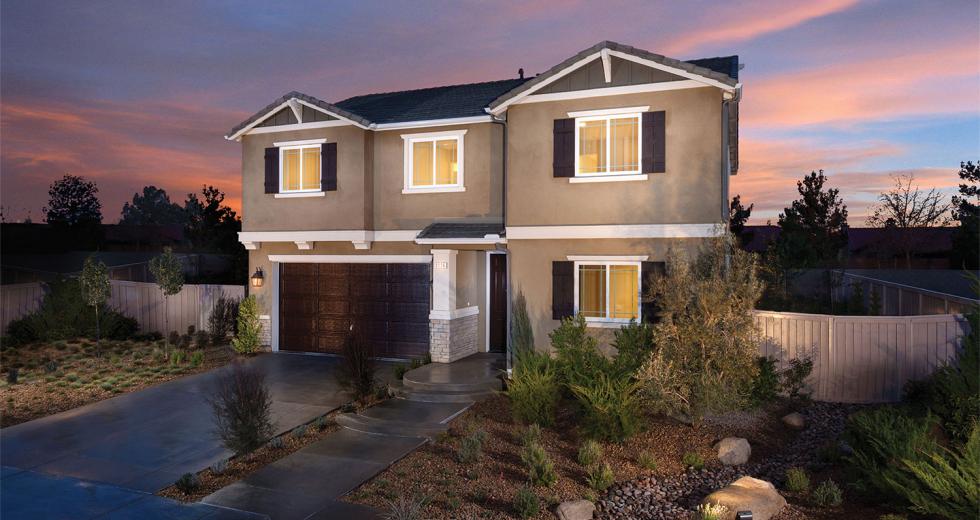The market for cutting-edge, sustainable homes has traditionally been small, primarily pursued by industry experts and boutique developers who can both appreciate and afford them. But that’s about to change.
The state of California has established an ambitious goal that by 2020 all new residential homes will meet zero-net-energy targets and produce at least as much energy as they consume, which means that new houses in communities of all stripes statewide will offer improved efficiency and energy reduction. While a noble environmental pursuit, the burden on homebuilders, expectations for utilities and added expense for homeowners may be a bigger hurdle than anticipated.
First established as a goal by the California Energy Commission in 2007, the zero-net-energy target was derived from the Global Warming Solutions Act of 2006, or Assembly Bill 32, which requires the state to reduce its greenhouse gas emissions to 1990 levels by 2020. In response, the California Public Utilities Commission published a strategic plan outlining key goals and strategies to achieve that end, and Gov. Brown issued an executive order in 2012 supporting the targets.
The objective is to move stakeholders beyond a focus on short-term energy improvements to a more sustained market transformation strategy, which includes meeting minimum efficiency standards that are updated on a regular basis.
The energy commission updates the California Building Standards Code, or Title 24, every three years and plans to have the zero-net-energy measures built into the 2019 code cycle. According to CEC Commissioner Andrew McAllister, the organization is trying to be “sensitive to the usability of the code, giving builders options that meet their needs and providing pathways that are flexible.”
The state has also taken strides to ensure that utilities have incentives to invest in energy efficiency. One way is through a CPUC performance-based incentive that provides investor-owned utilities, or IOUs, with more revenue for running a well-managed energy efficiency program. Another is by decoupling profits from total sales so utilities won’t have a profit-oriented reason to sell more electricity.
Because the practice of energy efficiency is fairly new, homebuilders and utilities are turning to field experts and using special modeling software to determine energy input and output.
“Having a solar panel that isn’t connected to the grid is like having a computer that’s not connected to the Internet.” Ellen Hayes, Pacific Gas & Electric
Widely regarded as an authority in sustainable engineering, and someone the industry seeks for recommendations, Neil Bulger, energy modeling team manager for Oakland-based Integral Group, designs cost-effective systems for high-performance buildings. Using sophisticated modeling parameters, Bulger prioritizes the energy-saving potential and carbon reduction efforts for specific buildings, advising utility companies, developers and others on how to save energy.
He starts with a building’s envelope (walls, floor and roof) and then moves to the systems and equipment, like lighting, heating, solar and electronics, looking for energy hogs. Bulger estimates building envelopes account for about 50 to 70 percent of the energy consumed, while the systems and equipment make up the rest.
“The building envelope has been pretty well tuned-in for the last five to six years,” he says, “especially due to the more stringent standards included in the building code.” So the focus has turned to other prospects to gain efficiencies. Bulger is finding new opportunities for energy reduction with plug loads, or everyday electronic equipment that is permanently plugged in, something homebuilders are looking into as well.
Another way to reduce reliance on energy utilities is through the addition of clean, on-site renewable power generation, like solar photovoltaics. The cost of solar installation has dropped dramatically, and third-party financing has been added, making access more widespread. But one major downside is on the horizon: The federal investment tax credit is set to be reduced from 30 percent to 10 percent by the end of 2016.
“The larger solar companies should be able to weather the storm, but the federal investment tax credit reduction, along with expected reforms of electric rates and net-metering, will definitely have an impact on the industry,” McAllister says.
While sustainability practices come in many forms, they’re not cheap and historically have been optional purchases for homeowners. With the new goals, homebuilders are estimating the ZNE requirement will add another $25,000 to $50,000 to each home, but are hopeful that by 2020 some of the technologies’ costs will come down enough to cover the added expense of building energy-efficient structures.
Even with the increased price tag, Bulger believes the demand for zero-net-energy homes will continue to grow. “A zero-net-energy home places less demand on the grid,” he says. But that creates a challenge for utility companies seeking a balance between environmental stewardship and fiscal health.
“It’s a little premature for us to determine what the impact is going to be,” says Alex Araiza, Sacramento Municipal Utility District’s senior product services coordinator for customer solutions, “but like other utilities, SMUD is watching policy to determine impacts.”
SMUD anticipates that shifts in technologies will offset some of the reductions in revenue with ZNE homes. For example, the increase in electric vehicle sales is leading to more EV batteries being charged at home or through remote terminals, creating an opportunity for an alternate revenue source.
Pacific Gas & Electric agrees. “The electric grid will be just as important in the years to come because the grid is becoming the platform that makes it possible for people to plug in solar panels, batteries and charging stations,” says Ellen Hayes, senior manager of corporate relations for PG&E. “Having a solar panel that isn’t connected to the grid is like having a computer that’s not connected to the Internet.”
IOU’s like PG&E, Southern California Edison, San Diego Gas & Electric and So Cal Gas have each launched ZNE pilot programs to promote California’s long-term energy goals while complying with the state’s requirement to have a well-managed energy efficiency program. As municipality-owned utilities, SMUD and Roseville Electric are not eligible to participate in the state-offered incentives, but both have implemented energy efficiency programs that are focused on meeting customer needs while maintaining costs. Roseville Electric’s Best Homes Program has won two national awards for combining solar energy production and energy efficiency, while SMUD’s case-study homes allow the utility to deploy technologies and energy efficiency successes into builders’ production homes.
The new 2500 R Street community features the first 34
net-zero-energy homes in midtown Sacramento.

SMUD, in partnership with Sunverge Energy and developer Pacific Housing, recently put its policies into practice at the newly opened 2500 R Street community in Sacramento. The development, which features the first zero-net-energy homes in midtown, consists of 34 single-family homes that include standard energy features like compact fluorescent and LED lighting, high thermal performance windows and insulation, solar panels, electrical storage and Energy Star appliances.
To encourage homebuilders to maximize energy efficiency in their production homes, SMUD uses a sliding-scale incentive program based on a home energy rating system. Roseville Electric employs a similar tactic, offering builders a rebate to exceed Title 24 standards.
“Ultimately, a program like this allows each individual homebuilder to pursue options that are best for them” Araiza says, “since they can select those measures that are the most cost effective and give them the greatest return.”
Homebuilder KB Home has made the ZNE practices part of its ongoing research and development, viewing the recommendations as an opportunity to generate more traffic to its residential offerings. One of those products is KB Home’s Double ZeroHouse, an energy- and water-efficient home that produces as much energy as it consumes.
Other regional builders like Lennar Homes, Pulte Homes, Elliott Homes and Meritage Homes are also implementing zero-net-energy targets.
In October 2014, KB unveiled its first zero-net-energy home in the Capital Region, dubbed Double ZeroHouse 3.0. The 2,600-square-foot home in the Blackstone community of El Dorado Hills is the first of its kind, with renewable energy generation and storage capabilities. The home incorporates increased insulation, upgraded HVAC units, high-performance windows and LED lighting and technologies that can be controlled from a tablet or smartphone. The entire house is designed to conserve water and saves about $4,500 a year in energy and water costs.
According to Dan Bridleman, the company’s senior vice president of sustainability, technology and strategic sourcing, the goal is not to necessarily create a custom-designed home, but to take an existing floor plan and elevation and convert it to a zero-net-energy residence. In that way, KB Home can convert any home to a ZNE home.
“To make the process somewhat cost efficient,” he says, “the home needs to be reproducible in the community.”
KB Home starts by adjusting the building envelope through advanced framing techniques, upgraded windows and installing insulation on the attic roof deck. The homebuilder then tackles the home systems, upgrading the HVAC and water heaters to higher-efficiency models and upgrading the lighting.
But cheap it’s not. True, the monthly savings to heat, cool, light and run the appliances in the ZeroHouse 3.0 come in around $330 when compared to a typical resale home. But on the flip side, the energy efficiency, solar systems and battery storage upgrades add about $45,000 to the home’s total cost.
“By continuing to work with our suppliers and trade partners, we would expect to reduce the cost and close the gap between a standard home and a ZNE home,” Bridleman says. “Ultimately, the upgrades need to be a bonus, and not something that is cost-prohibitive.”
Recommended For You

Bright Future
California’s new lighting requirements are raising questions, so here are 4 to ask
In California, lighting systems in commercial buildings account for an average of 35 to 40 percent of a facility’s total electrical use. That makes lighting systems the greatest target for potential savings as the state aims to achieve zero net energy in commercial buildings by 2030. Here’s what you need to know to get compliant.

Putting the Fab in Pre-Fab
Modular construction cuts construction and energy costs
The final stages of construction at a trend-setting apartment project in San Francisco’s SoMa neighborhood, known by its address at 38 Harriett St., largely resembled a life-sized game of Tetris.

In the Dark?
6 steps to navigating Title 24’s new lighting standards
The updated Title 24 energy efficiency standards will greatly impact how property owners design, construct and renovate buildings. Bernie Kotlier, co-chair of the nonprofit California Advanced Lighting Controls Training Program, shares the best ways to navigate the changes:

9 Ways to Sweeten Your Lease Terms
Budgets are finite—Spend smart to maximize your outcomes
Whether you’re looking for tenants or shopping for space: Here are some tips that might sweeten the deal or — if overlooked — can make one go sour.



